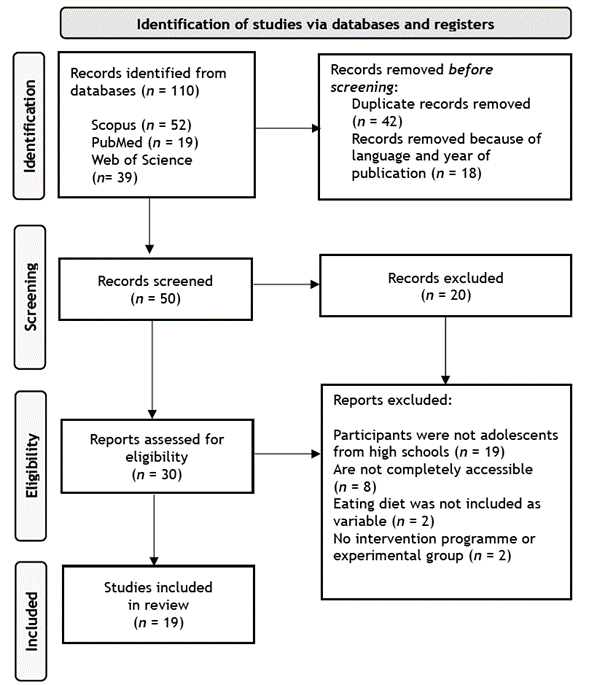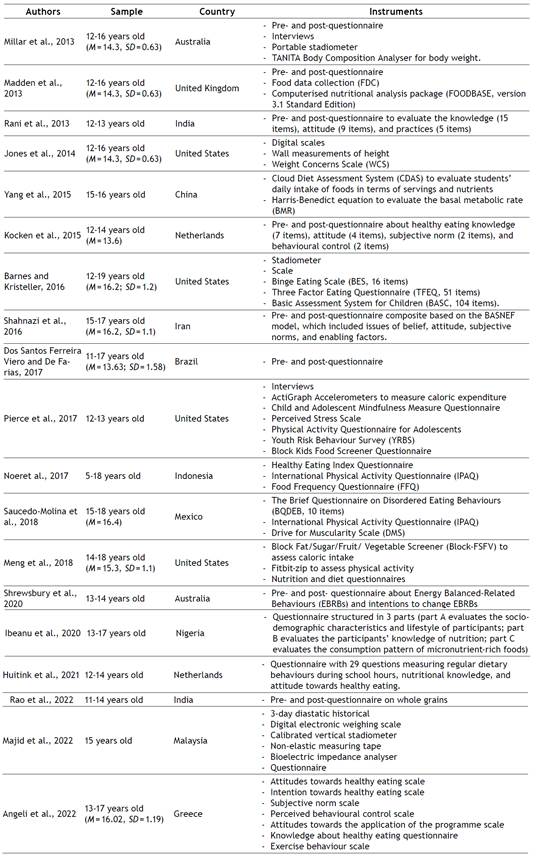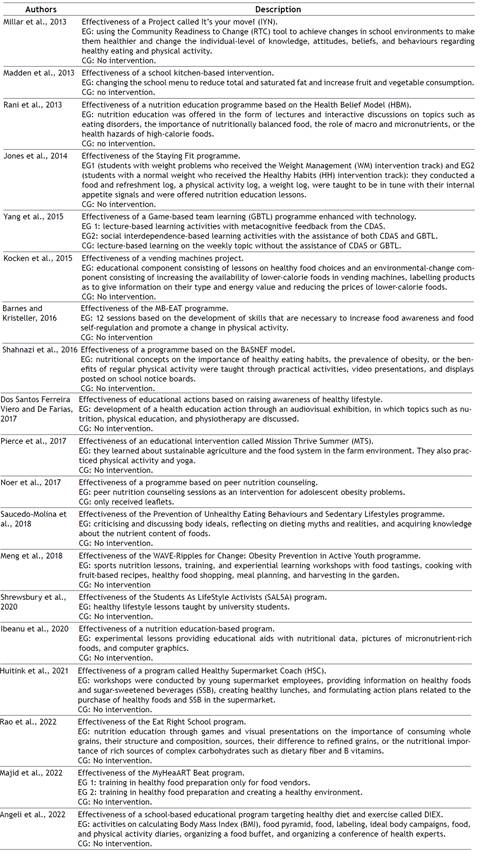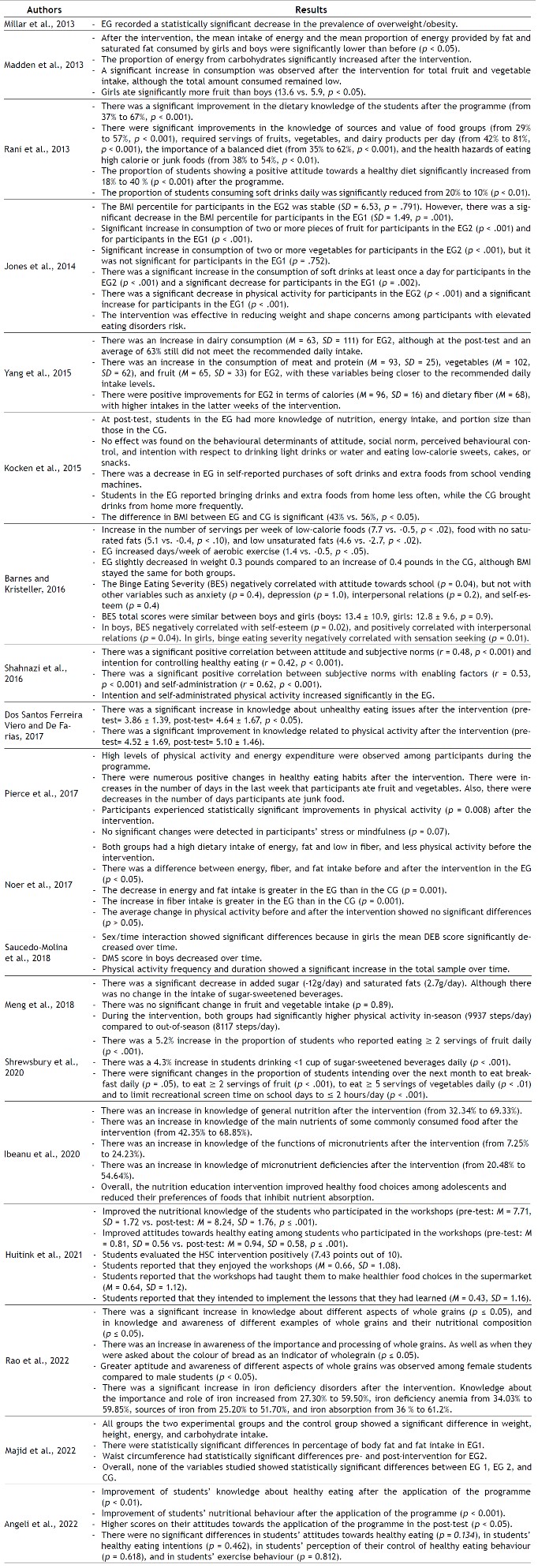Introduction
The Global Nutrition Report (2022) apprises that the level at which obesity rates and nutrition-related diseases are increasing is alarming. In fact, it is estimated that 254 million children and adolescents will have obesity problems by 2030 (Finkelstein et al., 2012). In consensus with Dhauvadel et al. (2019), the reason is that adolescents do not have adequate knowledge regarding their nutritional needs and the quality of their diet is quite poor.
Adolescents are considered a vulnerable group due to the high nutritional requirements for growth, reproductive maturation, and cognitive transformations (Das et al., 2017). In addition, unfavourable changes in food consumption patterns and lifestyle, risky eating behaviours, and susceptibility to environmental influences are observed (Moitra & Madan, 2022). Adolescents develop their own eating habits, which may persist in adult life (Patton et al., 2016). Adolescence is therefore a critical period for the prevention of weight problems and obesity (Langford et al., 2015).
Weight problems in adolescence: Causes
In recent times the influence of environmental changes has increased the prevalence of obesity among teenagers (Jebeile et al., 2022). Dietary factors contributing to the risk of obesity in this population group include the consumption of ultra-processed foods or sugary drinks (Ishak et al., 2016), driven by pervasive marketing and advertising (Liu et al., 2019; Mahumud et al., 2021). The food industry uses the media to promote unhealthy food and beverages (Popkin, 2015). Not only the advertisements in the media but also Information and communication technologies and food delivery online platforms influence people to consume this type of food and drinks (Indrayana & Palupi, 2014). Moreover, Robinson et al. (2017) stated that a large amount of daily screen time means that sedentary time increases at this age, while physical activity levels decrease. Unfortunately, children spend a lot of time using their electronic gadgets instead of doing exercise (Bentley et al., 2016).
Weight problems in adolescence: Consequences
Adolescents who are overweight or obese face physical, mental, and social health problems, both in the short and long term (Sagar & Gupta, 2018). Depression, stress (Roy et al., 2021), low self-esteem, anxiety (Fox et al., 2016), behavioral problems, and bullying (Waasdorp et al., 2018) are some of the consequences suffered by adolescents with weight problems. In addition, Gow et al. (2020) affirmed that they have a negative body image and lower body satisfaction. Obesity during childhood contributes to later adulthood obesity too (World Health Organisation, s.f.a).
According to the World Health Organisation (2021), obesity and weight problems also lead to serious health problems such as type 2 diabetes, cardiovascular diseases, musculoskeletal disorders, and various forms of cancer, among others. In this sense, 17.9 million people die every year because of cardiovascular diseases (World Health Organisation, s.f.c). These illnesses can be caused by an unhealthy lifestyle (American Heart Association, 2015) which is considered a risk factor.
Studies related to effects of nutrition programs in schools
Previous studies have shown that nutrition intervention programmes improve adolescents’ nutritional knowledge and food consumption patterns (Sharif et al., 2020), leading them to make healthy dietary choices in their daily lives (Medeiros et al., 2022). In fact, Gómez et al. (2019) support the idea that educational programmes improve not only their nutritional knowledge but also their adherence to the Mediterranean diet in primary school students. In this sense, Gámez-Calvo et al. (2022) and Collado-Soler et al. (2023) carried out a systematic review of intervention programmes at that stage. Gámez-Calvo et al. (2022) found that most of the intervention programmes modify eating behaviours and increase the level of physical activity in children. Further, Collado-Soler et al. (2023) affirm that these types of programmes improve students’ knowledge and healthy habits.
What’s more, Lundborg et al. (2022) search for the long-term effects of these programmes during childhood. They found that school lunches influence children’s health outcomes. They could decrease the probability of suffering any unhealthy condition (by 8% if children are exposed 9 years to this type of politics). Moreover, the levels of mortality, hospitalisations, disability, sick leave, etc. in these people are small and insignificant. However, the health benefits faded out unless they occurred at important stages for growth.
The most influential factors in their implementation in schools are macro politics, financial implications, school priorities, the responsibility of stakeholders, and environ mental and social characteristics (McIsaac et al., 2019). These are the reasons why it is so important to ensure synergy and coordination among different system levels.
Impact of the school environment on healthy eating habits in adolescents
According to Pulimeno et al. (2020), the school is the ideal environment for developing health education programmes. These programmes are aimed at acquiring both social and environmental skills and opportunities that influence students’ healthy eating (Meiklejohn et al., 2016) while motivating them to make healthy lifestyle choices (Kaveh et al., 2018). Moreover, acquiring this nutrition education at school will enable adolescents to positively influence the dietary choices and practices of their family and friends (Liu et al., 2021.
Creating a good intervention programme is not easy. Hargreaves et al. (2022) proposed several recommendations in order to develop and implement policies and interventions related to nutrition. What is most important is to cut across sectors, it is essential that these policies and interventions are supported by education, health, and food systems, social protection and digital media.
Finally, as well as the programmes developed, the quality of the food offered in school canteens or vending machines is a determining factor in the prevention of obesity (Billich et al., 2021), which should include products that promote a balanced diet, as opposed to those products that are high in sugars, fats and salt (Wolfenden et al., 2017).
For all the above-mentioned reasons, it is very important to foster healthy eating among adolescents. High schools are a good option if we consider that students spend many hours there and are influenced by this environment (Nathan et al., 2011). Nutrition educational programmes must contribute to people’s health (Oostindjer et al., 2017) and healthy eating patterns (Ismail et al., 2021). In this sense, the main objective of this paper is to investigate the effectiveness of several nutrition intervention programmes in adolescents aged 11-19 with respect to nutritional knowledge and behaviours.
Method
For the processes of searching and writing this article, we considered the statements of the Preferred Reporting Items for Systematic Review and Meta-Analyses 2020 (PRISMA statement; Page et al., 2021).
Literature search
The databases chosen for the search of studies were Scopus, PubMed, and Web of Science. They were screened from October 2022 to January 2023 with the objective of compiling the most complete list of studies possible. This search was undertaken by two of the authors independently, based on the agreement regarding the string search. We looked for relevant articles concerning nutrition programmes in high schools published in the last 10 years.
We used the following descriptors: (“PRE” AND “POST”) AND (“dietary behaviour” OR “healthy eating behaviour” OR “healthy food” OR “healthy diet” OR “healthy eating” OR “healthy nutrition” OR “healthy habits”) AND (“secondary education” OR “secondary school” OR “postprimary education” OR “high school” OR “bachillerato” OR “bachelor’s degree” OR “baccalaureate” OR “bachelorship”).
Inclusion and exclusion criteria
We have considered the following criteria during the selection process:
Articles from scientific journals were accepted, whereas other types of studies such as gray literature were refused;
Experimental or quasi-experimental articles were accepted. We refused articles without an intervention programme, a pre- and post-intervention, or an experimental group;
Articles in English or Spanish language were included, whereas articles written in other languages were refused;
Participants were required to be adolescents in high school, and studies with another population group or students from other educational stages as samples were refused.
Nutrition intervention programmes in high schools were included, while articles whose variables were different from the food diet, such as postural control, were refused;
Articles with open access were included, while articles to which we did not have complete access were refused.
Article selection and data extraction
Firstly, 110 articles were found by means of an automatic search. Articles published before 2013, repeated studies, and articles written in languages different from English or Spanish were removed, so we screened 50 articles in total. Then, applying the above-mentioned inclusion and exclusion criteria, 30 articles were selected for reading in detail. Finally, 19 articles were included in our systematic review. Figure 1 illustrates the selection process.
Two independent researchers extracted the following data from the 19 articles selected: authors’ names, year of publication, sample size, country, instruments used, variables measured, description of intervention programmes, and main results. Then, the information was validated by a third author.
Study quality assessment
The authors discussed the descriptors and reached an agreement. Then, the literature search and article selection were carried out by two authors independently. Disagreements between the two reviewers were resolved by consensus. To calculate inter-reviewer reliability, the number of agreements was divided by the total number of disagreements. The result was then multiplied by 100 to obtain the percentage, resulting in 96%.
Results
Study characteristics
We analysed 19 articles in detail from which some data were extracted. Regarding the geographic location, there is a great variety. 6 articles were from Asia, 6 from America, 4 from Europe, 2 from Australia, and 1 from Africa. The country most studied was the United States (4 out of 19) followed by the Netherlands, India, and Australia (2 articles per country). The remainder of the countries were studied in only one article.
The age range was from 11 to 19 years old, predominately from 12 to 16 in more than 10 articles. We found articles in all of the years selected following the inclusion criteria except for 2019. Table 1 shows the characteristics of the articles analysed.
Intervention programmes
The effectiveness of an intervention programme depends on its aims, methods, and activities, among other factors (Dudley et al., 2015). For this reason, we found a wide range of different intervention programmes. All of the included articles have experimental and control groups in order to compare the differences among the groups. There are no repeated programmes; each article uses its own projects. On Table 2, the description of the different intervention programmes of the articles selected can be seen.
Findings
Although different programmes have been carried out in each article, the findings can be explained with a close relationship. Students in experimental groups have improved their nutritional knowledge in general (Ibeanu et al., 2020; Rao et al., 2022), especially about diet and food groups (Rani et al., 2013), nutrients in commonly consumed food and their functions the importance of physical activity (Dos Santos & De Farias, 2017). The development of knowledge improves the eating behaviours of students (Angeli et al., 2022).
These types of programmes teach them to make healthier food choices (Huitink et al., 2021). In this sense, there was a decrease in the consumption of fat, saturated fat, carbohydrates, soft drinks, food from vending machines, junk food, and added sugar (Jones et al., 2014; Kocken et al., 2015; Madden et al., 2013; Meng et al., 2018; Noer et al., 2017; Pierce et al., 2017; Rani et al., 2013). On the contrary, healthy eating has increased. Shrewsbury et al. (2020) found a daily increase in fruit intake of 5.2%. Other authors also found this increase not only in fruit but also in vegetables (Jones et al., 2014; Madden et al., 2013; Pierce et al., 2017) and meat and protein (Yang et al., 2015). Although Meng et al. (2018) found no significant change in fruit and vegetable intake, and Kocken et al. (2015) found no effect on the intention of drinking light drinks or water and eating low-calorie sweets, cakes, or snacks.
Physical activity has also increased following the intervention programmes. We found significant differences in almost all of the studies selected, except for Noer et al. (2017) who affirmed that there were no significant differences between pre and post-tests.
All these benefits of intervention programmes make the prevalence of weight problems and obesity decrease (Millar et al., 2013), establishing significant differences between groups (experimental and control groups) in the Body Mass Index (Kocken et al., 2015). Moreover, Saucedo-Molina et al. (2018) affirmed that disordered eating behaviours decreased in girls over time. Regarding the differences between genders, we also found that girls ate significantly more fruit than boys (Madden et al., 2013) and girls have greater aptitude and awareness of different aspects of whole grains (Rao et al., 2022).
Finally, intervention programmes change the attitudes of students in EG towards a healthy diet and cause changes in the intentions for the future of these people (Rani et al., 2013; Shrewsbury et al., 2020). However, Angeli et al. (2022) found no significant differences in students’ attitudes towards healthy eating, healthy eating intentions, perception of their control of healthy eating behaviour, and exercise behaviour (see Table 3).
Discussion
The purpose of this systematic review was to examine the effectiveness of several intervention programmes in promoting healthy nutrition and physical activity in high schools. In general, the application of these types of programmes was satisfactory and improved knowledge and behaviours.
Firstly, our results showed that health education programmes have a positive impact on students’ knowledge. This is in line with the Elias et al. (2018) study which affirms that nutrition knowledge was developed among physically active people. We also found previous studies along this line. Little et al. (2002) found a significant increase in nutrition knowledge in a low-income community, especially among girls. In addition, Arlinghaus and Johnston (2017) affirm that education on a specific topic increases personal skills and awareness.
Secondly, it is also important to highlight that there is a relation between knowledge and nutrition choices, as we can verify in our results. This is consistent with Koca and Arkan (2020) who say that knowledge affects students’ habits. However, there are other factors implicated in these choices (Partida et al., 2018). Students are influenced by gender (Guttersrud & Sverre, 2015) and their environments (Worsley, 2002): family customs, what is socially accepted as cool, and friends’ habits. The differences between genders found in terms of eating fruit (Madden et al., 2013) and having a greater aptitude and awareness (Del Rio et al., 2022) are supported by another study that affirms that girls give more importance to health than boys (Lee et al., 2019).
In any case, investigating the relationship between nutritional knowledge and the quality of dietary intake can help adopt effective strategies (Joulaei et al., 2018). Regarding the quality of diets, we found an increase in the consumption of fruit and vegetables (FV) (Jones et al., 2014; Pierce et al., 2017; Yang et al., 2015) and a decrease in fat and saturated fat food (Madden et al., 2013; Meng et al., 2018; Noer et al., 2019), soft drinks (Jones et al., 2014; Rani et al., 2013) and junk food (Pierce et al., 2017). The results regarding fruit and vegetable intake are affirmed by Foley et al. (2017) who showed that their sample got the recommendation for its consumption. Years ago, Lytle et al. (2004), Siega-Riz et al. (2011), and Wilson et al. (2012) also showed an improvement in short-term FV intake after intervention programmes. Moreover, Huitink et al. (2021) affirm that the programmes teach students to make healthier food choices at the supermarket. In this sense, nutrition programmes inside the school could be enriched with supermarket tours. Nikolaus et al. (2016) demonstrated that these tours increase knowledge, skills, and positive attitudes. On the other hand, it was corroborated that the school canteen influences the students’ choices (Wolfenden et al., 2017) because they perceived that healthy food is sold in the canteen (Mohammadi et al., 2020). Many students purport buying unhealthy food or drinks during school hours (Ridder et al., 2017), for this reason, canteens and food shops around high schools should encourage healthy food choices (Timmermans et al., 2018).
Thirdly, we found that in almost all of the articles it was affirmed that physical activity increased following the intervention programmes. Saucedo-Molina et al. (2018) found a significant and positive effect in the short-term, but these changes were not maintained in the long-term. In the follow-up, scores are better than in the pre-test but worse than in the post-test. These results are in accordance with previous research which affirmed that short-term changes fail at the follow-up (Stice et al., 2011). Moreover, Jones et al. (2014) establish differences between overweight people who increase their physical activity and normal-weight people. The impact of physical activity on the overweight peo-ple group is very positive even though it was an Internet-based intervention. In this sense, these types of interventions have good results in sedentary people (Carr et al., 2008).
As we said before, the prevalence of weight problems and obesity decreased (Millar et al., 2013), establishing significant differences between groups (experimental and control groups) in the Body Mass Index (Kocken et al., 2015). BMI is an indicator of weight problems and obesity (World Health Organisation, s.f.b). Our results are supported by D’Amato-Kubiet (2013). He found that the BMI was reduced when nutritional knowledge improved among young people.
Finally, for these findings that were not statically significant, Álvarez et al. (2019) indicate that students sometimes need more time to assimilate specific information. What is more, knowledge alone is not enough to change people’s behaviours (Vaitkeviciute et al., 2015). Conceivably, it would be better if the programmes had included educational and practical components. Several studies have shown that policies for healthy school food, provision of fruit and vegetables, and canteen-based healthy food are essential (Nik et al., 2018). Therefore, we cannot forget that a strong intervention should be carried out (Downs & Demmler, 2020).
Conclusion
To conclude, nutrition intervention programmes at high schools have a great impact on nutritional knowledge and behaviours. The main goal of this systematic review was to investigate the effectiveness of several nutritional programmes in the high school stage. As we were able to corroborate, students improved their knowledge in this area and increased healthy intake. In this sense, Schlechter et al. (2016) affirmed that school environments and families are two essential factors in modifying adolescents’ dietary behaviours.
We followed the PRISMA methodology which is recommended in social science research. It stands out for its transparency and openness to comments. However, we encountered a few limitations: publication year and type of publication. Our objective was that this systematic review would be current and relevant. For this reason, we refused articles that were not published in scientific journals as well as articles published before 2013.
Educational implications can be drawn from this article, as management teams at schools can verify the advantages of each type of programme and choose the best option to improve nutritional knowledge and attitudes among their students. Future work could emphasise a cross-programme that includes families and schools having the same objective, the health of adolescents.



















